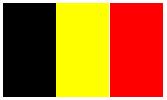
Belgium
Belgium is a small country in north-western Europe. It has 66 km (41 miles) of coastline along the North Sea. Belgium has an area of 30,522 sq. km (11,785 sq. miles), and a population of 10,040,939 (1993 estimate). It has cold winters with a high percentage of rainfall. With summer comes heat, and with the heat often comes humidity.
Four countries surround Belgium, one of them is the world�s smallest country, the Grand Duchy of Luxembourg. The other three countries are France, Germany and the Netherlands. Belgium is divided into nine provinces:
1. Antwerpen, with its diamond cutting industry.
2. Brabant, with the nation�s capital, Brussels, Bruxelles if French or Brussel in Dutch (population 1,000,000).
3. Hainaut.
4. West-Vlaanderen, with its World War I cemetaries and mixed farming.
5. Oost-Vlaanderen, with its lace making.
6. Li�ge, with its coal mining and weapons making.
7. Limburg, with its Building Museum at Borkrijk.
8. Namur, with its art.
9. Luxembourg, which is not to be confused with the Grand Duchy of Luxembourg, Belgium�s neighbour.
Included in these nine provinces are 596 local municipalities.
Belgium has an interesting history. From 51 B.C. to 349 A.D. Belgium was under Roman rule. The Franks then came in and established an empire with the capital at Tournai. Then Clovis (later to become king of the Franks) uninted the tribes of Gaul with the capital at Paris. From 768 to 814 A.D. Belgium was an important part of Charlamagne�s Empire. After Charlamange died, his grandsons tore up his empire.
Many wars followed, and Belgians were forced to be serfs. They livedlike slaves, never leaving their place of birth, unless they were forced into military service. In addition to that, Belgium was constantly raided by Vikings.
From 1384 to 1477 Belgium was under the Control of the House of Burgundy. In 1515 Spain brought Belgium and the Netherlands under its control. Sixty-five years later, in 1581, the Netherlands declared independance from Spain. The loss of trade with the Netherlands hurt Belgium. After the war of the Spanish Succession, Austria took control of Belgium. In 1794, France decided it wanted Belgium, and its troops forced Austria out. Three years later, in 1797, Austria formally gave Belgium to France.
Two things happened in 1815, first, Belgium joined the Netherlands, and second, Napoleon was defeated at Waterloo in central Belgium. In 1830 Belgium separated from the Netherlands. A year later the Kingdom of Belgium was formed.
At the start of World War I Germany invaded Belgium, despite its neutrality. In 1940 the Germans again invaded and defeated Belgium. Four years later, in 1944, Belgium was liberated from Germany. Finally, in 19993, Belgium became a federal state.
Belgium has three official languages: French, Dutch and German. German is spoken in little pockets in the East, while French is spoken in the southern half of the country. Dutch is spoken in the northern half of the country.
The school system is split into four parts. The church in French or Dutch, or the state in French or Dutch. Almost one half of the schools in Belgium are controlled by the church, and alot of the teachers are monks. At age twelve, children begin to learn a second language. It can be Dutch, French or English.
Alot of Belgium�s food is French. Other dishes, like Waterzooi and Paling in T�Groen, are striclty Belgian. Beer is the most popular drink in belgium, and oysters are a popular seafood dish.
Belgium�s most popular summer sport is bicycling. Next to that there�s motor racing. tennis and squash are other favourites, and walking and hiking are common hobbies. The most popular winter sport is skiing. In the provinces of Li�ge and Luxembourg are some wooded uplands called the Ardennes. These uplands are Belgium�s ski hills.
Puppet shows are a popular form of entertainment. Belgium has also produced cartoons, such as The Smurfs and Tin Tin.
Belgium�s currency is the franc. A franc equals 100 centimes. There are coins for 50 centimes, one, five, ten and 20 francs. There is also a 100 franc note.
Belgium exports many things. Some of the exports it is most famous for are its chocolate and crystal glass. Others include: fruit, fresh vegetables, flowers, plants, sugar, vegetable oils, canned food and beer.
Belgium does not import much. One thing it does import is raw diamonds, which are cut and polished in Atwerpen, and then exported.
Many crops are grown in Belgium. They include: hay, barley, potatoes, flax, fodder, sugar, oats, beets, hops, tobacco, wheat and maize. Grapes are grown indoors in heated greenhouses. Cattle and pig farming are also important.
Belgium�s voting system is proportional representation. It�s government is a coalition. In a coalition governmant, several parties form together to make the governmant, with the king as head of state. One problem with a coalition government is that if one party decides to pull out, the whole government may colapse. If that happens, the politicians will attempt to form another coalition. If that doesn�t work, an election will be held.
The Government is made up of two parts: the chamber of representatives, with 212 members, all elected, deals with all matters. The senate, with 182 members, two thirds elected, one third chosen by provincial councils or automatic right to position, deals with community and regional problems
Home

